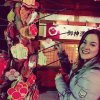With great anticipation, we took the Tohoku Shinkansen from Tokyo to Otawara. A rural city in northeastern Tochigi Prefecture, the region offers over a hundred different places to stay, and the array of activities and experiences to choose from are endless. We intended for a relaxing getaway before the year’s end, which we really achieved.
First day
Upon our arrival at Nasu-Shiobara Station, we met our Otawara Tourism coordinator, who provided us with a set of maps and brochures. We also received personalized maps to facilitate our bicycling around the farms, which made planning our routes easier.
We took a taxi to Otawara City and dropped at Suzuki Bicycles, where we rented two brand-new bikes—helmets included—for ¥1,500 each per day.
Then we headed for Sakura House, where our hosts Mr. and Mrs. Ishii were waiting. Their cheerful spirits greeted us, while the coordinator helped us check in. While they didn’t speak much English, the Ishiis are very experienced in catering to guests, and made everything go smoothly. We dropped off our backpacks and left to eat.
We rode the bikes to lunch at Farmers’ Cafe. Their set, at ¥1,400 each, includes a salad bar, a main, tea or coffee, and a sherbet. We picked our favorites from black beans, burdock, pâtés, and an assortment of vegetables and meats. For the main dish, I had a delicious beef ragout stewed in demi-glace sauce. My hubby chose a thin sliced sautéed seasoned meat.
Otawara’s own Maeda Farm directly runs the café, so almost all their food is locally sourced and prepared on the premises. There is also a meat shop.
We learned that near the restaurant, we could taste bread made with natural yeast and locally-grown rye, so we biked our way to Namakemono no panya (“sloth’s bakery”). I bought four delicious loaves of the 40-percent-rye bread, for ¥200 a piece.
Vegetable picking for dinner

Back in Sakura House, Mrs. Ishii lent us the gear to pick the ingredients of a succulent winter nabe (hot pot) straight from her vegetable garden. She showed us where to pick the leek, daikon, hakusai (Chinese cabbage), shungiku (Chrysanthemum leaves), and more.
We had lots of funny moments, as when we crossed the road with the cart full of daikon. The tofu, the carrots, the shiitake and enoki mushrooms, oysters, and hotate (scallops), were waiting for us in the kitchen. We also picked tōgarashi (Japanese chili peppers) and some delicate yuzu citrus fruits.
We loved the futons and the origami our host prepared for us. We did enjoy the ofuro and all the amenities. The house is well equipped with a new bathtub and two Western toilets.
Second day

A beautiful clear sky welcomed us. I captured a bit of the garden and the house akugoya, a little stone structure where, in the past, ashes were disposed of.
Kurobane: Haiku and Zen
We hurried to have the traditional earthy breakfast Mrs. Ishii prepared, which included fresh fruit. We checked out, but left our bikes and backpacks there, and departed for Kurobane.
We came to know that Basho stayed in the area for two weeks, allured by the delicious sake and food. The museum is pretty close to the temple. Around 9am, we got on the local bus and got off at the firemen memorial stop. We had a brisk morning walk, stopping to look at stones carved with Matsuo Basho’s haiku from his famous “Oku no hosomichi” (“The Narrow Road to the Deep North”) collection of poems and travelogue.
After a short stroll, we were at the gates of Daioji Temple, where young Buddhist priest Bungyo-san guided us through our first zen experience.
He explained the basics of Sōtō School meditation and handed us a brochure in English. He answered our questions and then proceeded with the meditation.
Later on, he showed us the temple, the garden, and even their museum. He talked about the history of the temple, pointing to the local feudal lord crest on the tatami mats.
Spending time at Daioji was an experience we treasured, and one almost impossible to come by at tourist attractions. The tour cost ¥1,500.
By the temple gates, we had a generously-sized bowl of tasty soba noodles with ayu (the renowned local fish) tempura for ¥1,300.
On our way down, we took pictures of the Nakagawa River, the building of Ashikaga Bank, and some old kura (warehouses) and shops.
Otawara Kominka (Japanese Traditional) House, onsen and Tanakaya pub

Back in Otawara, we packed our belongings and checked in at the Iwaki family house, an old wooden structure with vintage furniture. Mr. and Mrs. Iwaki showed us their farm, where they had just finished harvesting soybeans, and explained their year-round production cycles.
Later, we left for a much-needed thermal bath on the other side of town.
For dinner, we wanted to experience a rural pub, so we went to an izakaya named Tanakaya, a cozy place that really perked us up after the bike ride.
We tried the warmed jizake (a type of sake made with local water and rice) Kokoro, from the nearby Tentaka Brewery.
The affordable yet tasty selection of chicken, katsuni pork, and agedashi tofu dishes ranged from ¥350 to ¥950. I found the fried tofu to be deliciously otherworldly.
Back at the farmhouse, we sunk into the futon beds.
Monday

Mrs. Iwaki treated us to a homey Japanese breakfast and provided us with an espresso maker, which we thanked her for.
Before checking out, she walked us around while we took photos of their old warehouse and garden.
Then we rode to downtown Otawara, where we did a little shopping. There was an old-style sweets shop by the new Toko-Toko market, so we visited both establishments.
Next we had lunch at nearby Jintei. Our last teishoku, set meal, of fish and chicken for only a ¥1,000.
Lastly, we went the extra mile as we could neither resist the charms of the Kanadoro lanterns, nor the desire to visit Yakushi Temple to ask for a safe trip back to Tokyo.
We then returned the bikes and took a taxi back to the station.
A two-night stay with two breakfasts and one dinner worked out to a total of about ¥13,000 per person. The taxi ride between Nasu-Shiobara and Otawara Stations was around ¥5,000.
We were pleased by the freshness and high quality of the food in the countryside. However, we equally savored the conviviality with the locals, while having all the comforts of home. This was a trip worth repeating in the spring or summer.
Book your own rural stay
Just a one hour trip from Tokyo and now on sale – experience rural tourism for yourself in Otawara, Tochigi prefecture. Stay with your group at your very own private, traditional Japanese house.




































